Ultimate Guide to Eco-Friendly Decking
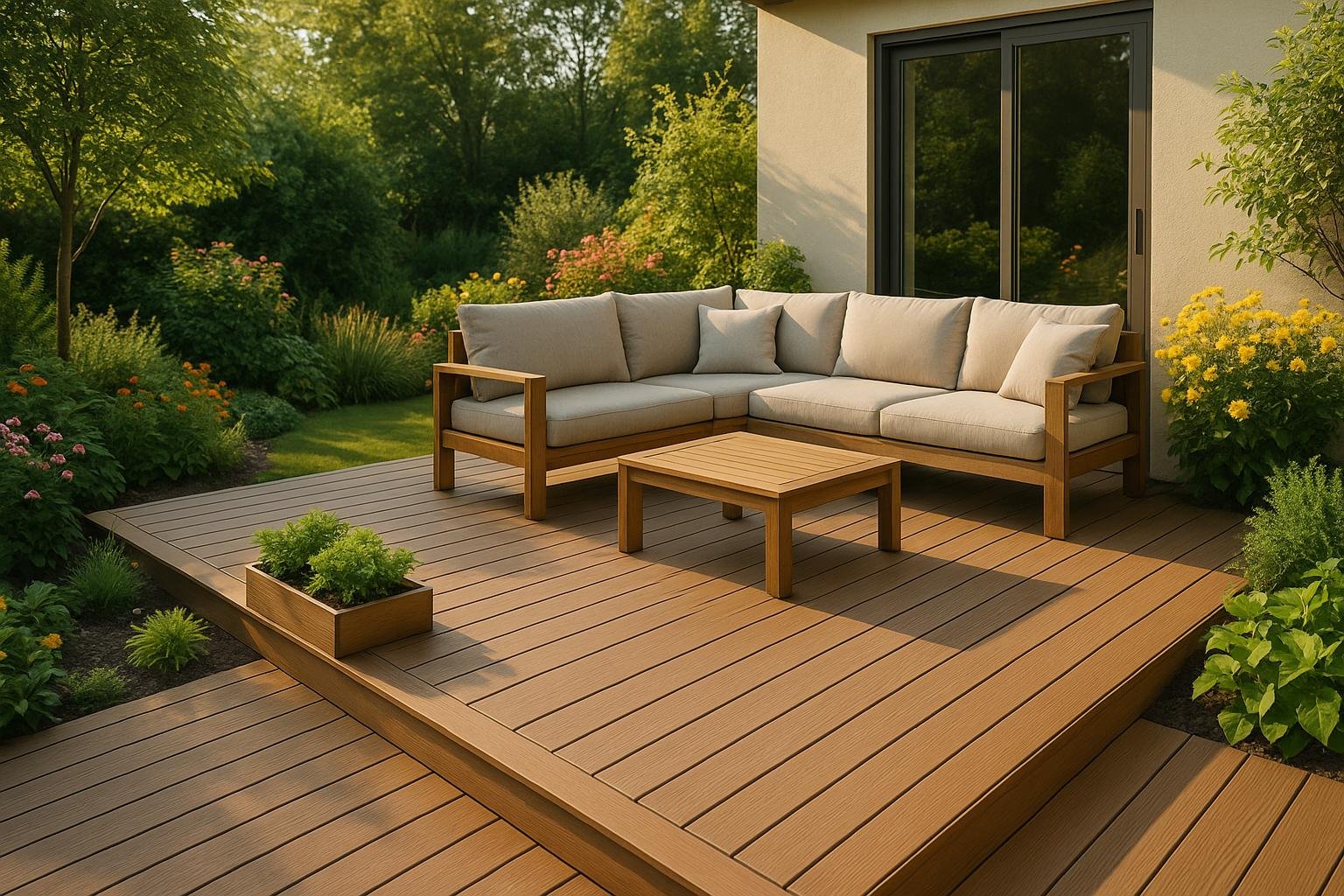
Key Benefits of Eco-Friendly Decking:
- Made from sustainable or recycled materials like composite, bamboo, or FSC-certified wood.
- Durable and long-lasting: Composite decking lasts 25–30 years, while bamboo can last 20–25 years.
- Low maintenance: Requires less cleaning and no chemical treatments compared to traditional wood.
- Environmentally conscious: Prevents waste and reduces carbon emissions. For example, Trex uses 95% recycled content and diverts 1 billion pounds of waste annually.
Popular Material Options:
- Composite Decking: Blend of recycled plastics and wood fibers, resistant to rot and pests, costs $15–$36/sq ft.
- Recycled Plastic Decking: 100% post-consumer plastics, weatherproof, low-maintenance.
- Bamboo Decking: Rapidly renewable, absorbs CO₂, requires moderate upkeep.
- FSC/PEFC-Certified Wood: Sustainably sourced, natural wood beauty, but needs regular maintenance.
Quick Comparison Table:
| Material | Lifespan | Maintenance | Cost per sq ft | Key Features |
|---|---|---|---|---|
| Composite | 25–30 years | Minimal | $15–$36 | High recycled content, durable |
| Recycled Plastic | 25+ years | Very low | Varies | 100% recycled, weather-resistant |
| Bamboo | 20–25 years | Moderate | Varies | Renewable, eco-friendly |
| FSC Wood | 10–15 years | High | $15–$25 | Natural beauty, sustainably sourced |
Why Choose Eco-Friendly Decking?
- Cost-effective: Less maintenance and longer lifespan save money over time.
- Eco-conscious: Reduces landfill waste and uses renewable resources.
- Attractive designs: Comes in a variety of colors, textures, and finishes to match your style.
Ready to build your perfect deck? Start by choosing materials that fit your budget, climate, and sustainability goals. Whether it's composite, bamboo, or recycled plastic, eco-friendly decking is a smart choice for your home and the planet.
How Eco-friendly Composite Decking is Manufactured

Decking Material Options
Eco-friendly decking provides options that combine sustainability with performance, offering materials that either boast high recycled content or come from renewable sources. Let’s break down the features and considerations of each type.
Composite Decking
Composite decking blends wood fibers with recycled plastics to create a sturdy, low-maintenance surface that mimics the appearance of natural wood. Take Trex, for instance - it’s made from 95% recycled and reclaimed materials [4]. Cladco composite boards go even further, using 100% recycled materials, which include 60% FSC-certified hardwood fibers and 40% recycled plastics [2]. EnviroBuild also stands out by utilizing up to 90% recycled materials and manufacturing with 100% wind energy [3].
"Composite decking is a durable, low-maintenance alternative to traditional wood decking. Made from a blend of wood fibres, plastic, and additives, it combines the natural look of wood with the enhanced strength and resilience of modern materials." – EnviroBuild [3]
This material is resistant to rot, warping, and pests [3], with a lifespan of 25–30 years [4]. Unlike traditional wood, composite decks don’t need staining, sealing, or painting - just a simple soap-and-water cleaning. Its non-slip surface makes it a practical choice for pool areas and busy spaces. On average, composite decking costs between $15 and $36 per square foot [4].
Recycled Plastic Decking
Recycled plastic decking takes eco-friendliness a step further by using 100% post-consumer plastics, with no wood content. It’s built to withstand harsh weather while requiring almost no maintenance beyond occasional cleaning. This material resists splintering, cracking, and fading, making it ideal for coastal areas or other challenging climates. Plus, it helps divert plastic waste from landfills.
Bamboo Decking
Bamboo is one of the fastest-renewing resources available, maturing in just 4–5 years compared to the decades it takes for hardwoods [5][9]. Its environmental advantages are impressive: one acre of bamboo can absorb about 10,000 pounds of carbon dioxide annually [6], and bamboo tissue products produce 30% fewer greenhouse gas emissions compared to those made from virgin forest fiber [7]. MOSO® Bamboo Decking, for example, is CO₂ neutral throughout its entire life cycle [9].
Thanks to modern processing techniques, bamboo can rival hardwoods in strength, offering a lifespan similar to premium species like ipe [8][5]. While it does require regular cleaning to maintain its look and performance, bamboo decking is a fantastic choice for those seeking a balance of sustainability and durability.
FSC and PEFC-Certified Wood
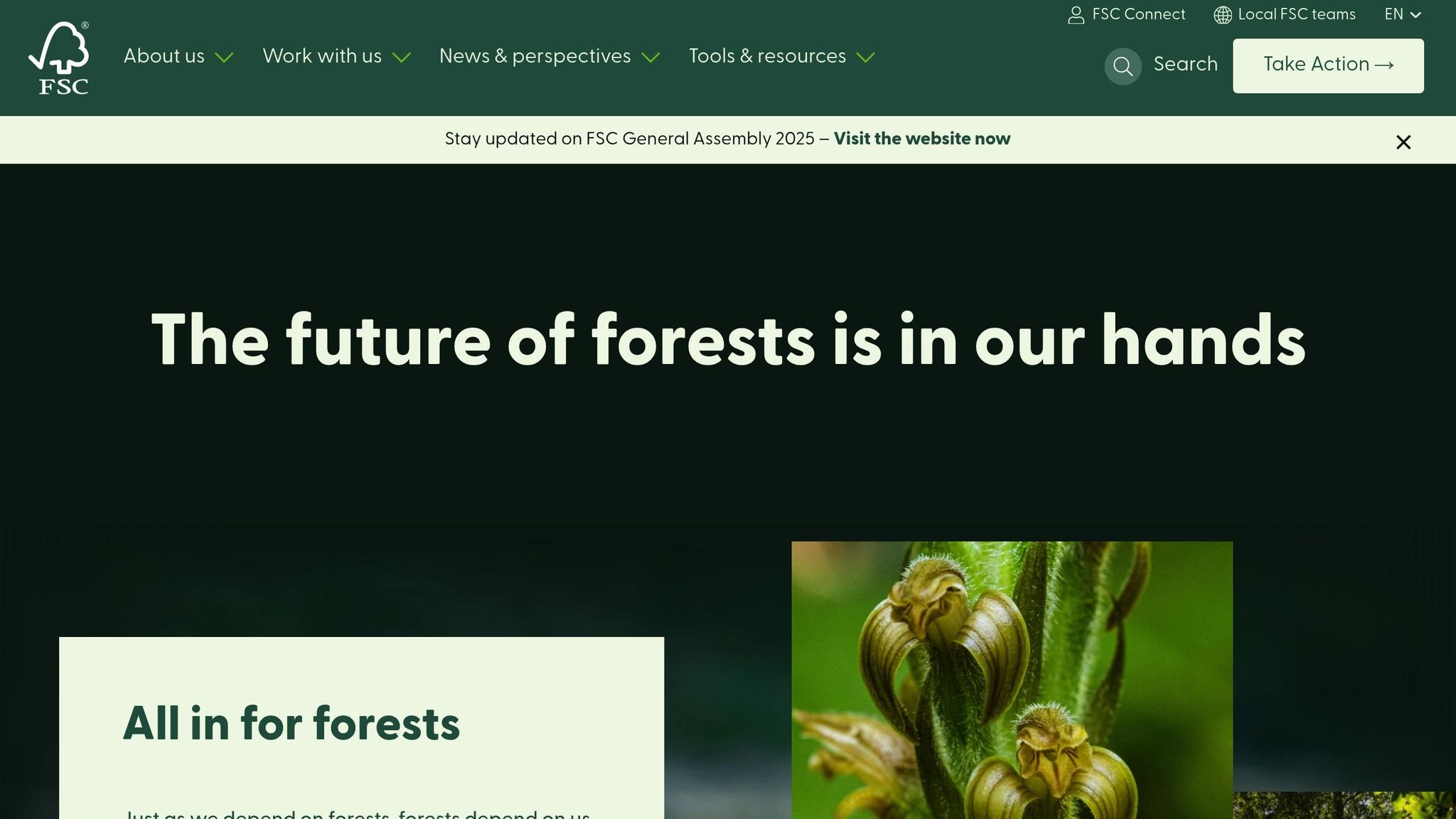
For those drawn to the natural beauty of solid wood, FSC and PEFC-certified lumber ensures responsible sourcing from sustainably managed forests. These certifications guarantee that the wood comes from ethical forestry practices. While certified wood decking delivers the warmth and charm of traditional wood, it does require consistent maintenance, including cleaning, staining, and sealing, to protect against weathering. Though it may cost more upfront than non-certified wood, its environmental benefits and aesthetic appeal make it a top pick for eco-conscious homeowners.
Material Comparison Table
| Material | Durability | Maintenance | Cost per sq ft | Key Benefits | Considerations |
|---|---|---|---|---|---|
| Composite | 25–30 years | Minimal cleaning | $15–$36 [4] | High recycled content; no staining needed | Higher initial cost |
| Recycled Plastic | 25+ years | Very low | Varies | 100% recycled; exceptional weather resistance | May lack a natural wood appearance |
| Bamboo | 20–25 years | Moderate | Varies | Rapid renewal; eco-friendly | Requires regular cleaning |
| FSC/PEFC Wood | 10–15 years | High (regular upkeep) | $15–$25 [10] | Natural beauty; responsibly sourced | Needs frequent maintenance |
Choosing the Right Eco-Friendly Decking
Picking eco-friendly decking involves balancing environmental responsibility with practical needs. The trick is finding materials that suit your climate, lifestyle, and aesthetic preferences while delivering long-term performance.
Key Factors to Consider
Start by assessing how well decking materials align with your local climate. Think about factors like sun exposure, humidity, moisture levels, and temperature swings. For example, in areas with high humidity, materials like composite decking can be a smart choice since they resist moisture and require less upkeep. Similarly, composite options are less prone to warping or cracking in extreme temperatures [12].
Budget is another important consideration. While some materials may have a higher upfront cost, they could save money in the long run. Composite decking, for instance, often eliminates the need for frequent staining and sealing, unlike wood [13] [14].
Your deck’s appearance matters too. Choose colors and textures that complement your home and landscaping. Bamboo offers a natural, grainy look, while composite materials provide a uniform appearance that remains consistent over time [12].
Safety should never be overlooked. Opt for decking with slip-resistant properties, especially if you live in a rainy area or have a pool nearby [12].
Lastly, confirm that the materials you select meet environmental standards. Look for certifications like FSC (Forest Stewardship Council) for wood products [11]. For composite decking, check claims about recycled content and verify their accuracy to ensure the materials are truly sustainable.
Checking Warranties and Claims
Protect yourself from misleading claims by verifying certifications and warranties. If a company advertises FSC or PEFC certification, ask for their certification numbers and confirm them through official databases [16]. The FSC website, for example, allows you to trace a product's supply chain back to its origin, ensuring it comes from responsibly managed forests [16]. Similarly, the PEFC database offers details on certified products and accredited certification bodies [15].
Don’t forget to review warranty terms. Many composite decking brands offer extended warranties covering issues like fading, staining, or structural damage. Compare warranties carefully to understand what’s included - and what’s not.
For recycled content claims, legitimate manufacturers should provide specific percentages and supporting documentation. This transparency ensures you’re making an informed, sustainable choice.
Using AI Tools to Visualize Decking Options
AI tools can make planning your sustainable deck easier and more exciting. These tools let you visualize how different decking materials will look in your space with realistic 3D renderings. You can experiment with layouts, colors, textures, and styles tailored to your outdoor area [17].
Augmented reality (AR) tools add another layer of realism, allowing you to virtually design your deck and explore different shapes, shades, and finishes.
Platforms like AIGardenPlanner go even further by integrating decking options into complete landscape designs. Simply upload photos of your yard, and the tool will show how various decking materials fit with over 50 garden styles. Its AI Plant Advisor even recommends plants based on your location and climate, ensuring your decking choice blends seamlessly with your surroundings.
These AI-powered tools also analyze environmental factors like soil type, sunlight, and drainage patterns [17]. For instance, if your yard gets intense afternoon sun, the tool might suggest materials that perform better under those conditions. By combining visual planning with environmental insights, you can create a deck that not only looks great but also meets your practical needs and aligns with your eco-friendly goals.
sbb-itb-4d6a8dd
🚀 Ready to Reinvent Your Garden?
Join thousands of homeowners who have transformed their gardens using our AI design tool. Upload one photo to explore endless possibilities.
Get your AI garden designs →Installation Best Practices
Installing eco-friendly decking isn't just about putting materials together - it's about using methods that reduce waste, protect your surroundings, and ensure your deck lasts for years. A thoughtful approach can make a big difference in both the environment and the performance of your deck.
Eco-Friendly Installation Methods
Reducing waste during installation is key. Renaissance Building Company captures this idea well:
"We take a thoughtful approach to deck layout, optimizing cuts and material use to minimize waste while maximizing efficiency and sustainability" [11].
Plan each cut before making it, and consider using prefabricated sections to keep scrap material to a minimum.
Hidden fasteners are another smart choice. Instead of traditional screws that pierce the deck's surface, these attach from underneath or along the edges. This method avoids visible holes, lowers the risk of moisture damage, and gives your deck a cleaner, polished look [11].
Sealants also play a role in eco-friendly installation. Opt for low-VOC, water-based sealants, which release fewer harmful chemicals into the air and break down more safely over time. Look for adhesives labeled as low-VOC to align with your sustainable goals [11].
The substructure is just as important. For a durable and environmentally conscious base, consider recycled metal or composite joists. Pair these with recycled steel screws and brackets to complete a sustainable foundation [11].
Finally, take care to protect the site itself. Instead of clearing large areas, work section by section. Use temporary ground protection to avoid soil compaction from heavy equipment or material storage. These steps not only safeguard the environment but also set the stage for a successful installation.
DIY vs. Professional Installation
Deciding between a DIY approach and hiring professionals depends on your skills, time, and the complexity of your project. If you're comfortable with tools like a circular saw, drill, and level - and have a good grasp of local building codes - DIY might be a good option for simpler projects. For example, straightforward rectangular decks under 200 square feet are manageable for those with intermediate carpentry experience [24].
DIY installation gives you hands-on control over materials and teaches skills you can use for future maintenance. However, professional installation is often the better choice for complex designs, elevated decks, or projects requiring structural changes. As Dream Decks highlights:
"Professional builders handle complex designs, navigate local building codes, and manage permits efficiently" [23].
While DIY can save you 30-50% on labor costs, mistakes can be expensive. Professional installations often include warranties and ensure proper techniques, reducing the need for costly repairs down the road. Dream Decks also points out:
"Professionally built decks often require less long-term maintenance and minimize the risk of costly mistakes" [23].
Time is another factor to consider. A professional crew can complete a 300-square-foot deck in 3-5 days, while a DIY project might take you several weekends, especially if you're new to deck building [24].
If you go with a contractor, make sure they have experience working with eco-friendly materials. Ask for references from similar projects and verify their familiarity with sustainable building practices [24].
Regional Considerations for U.S. Homeowners
Building codes vary across the United States, so it's crucial to check local regulations before starting your project. TimberTech emphasizes this point:
"Building codes are written to protect homeowners and provide for safer, more durable installations. They also help maintain homeowners insurance coverage and provide peace of mind to a prospective buyer when it's time to sell" [19].
In wildfire-prone areas like California and Colorado, fire safety is a priority. Use fire-resistant composite materials and maintain proper clearances from structures. These precautions can make all the difference in protecting your property [20][21].
Climate also plays a role in installation techniques. In the humid South, ensure proper ventilation under your deck to prevent moisture buildup. In colder Northern states, account for frost lines and use expansion joints to handle freeze-thaw cycles. Coastal regions, on the other hand, require corrosion-resistant fasteners to combat salt air [22].
Structural needs depend on your deck's height and exposure to wind. Most areas require railings for decks over 30 inches high, and elevated decks may need engineered foundations. Consulting local experts ensures your deck meets all structural requirements [19][20].
Environmental regulations can also shape your project. Some areas enforce erosion control measures, limit when you can disturb soil, or require special permits for sensitive ecosystems like wetlands. Following local guidelines not only ensures compliance but also protects the environment [22].
The National Green Building Standard (NGBS) offers sustainability guidelines referenced by many local codes. Aligning your project with these standards helps meet both current regulations and future expectations [22].
Long-Term Care and Maintenance
Taking care of your eco-friendly deck ensures it stays attractive and lasts for years. Many sustainable decking options demand less effort than traditional wood, but each material comes with its own care instructions.
Care Routines for Different Materials
For composite decking, maintenance is as simple as regular cleaning with mild soap and water - leaving you more time to relax outdoors. Sweep away leaves and debris regularly, and for a deeper clean, use warm water mixed with mild dish soap. A stiff natural fiber or medium-stiff nylon brush works well for scrubbing. Quickly blot spills, and for snow, ice, or mold, clear the buildup with a plastic shovel and scrub with soapy warm water when needed[25].
Recycled plastic decking follows a similar low-maintenance routine. Regular sweeping and occasional cleaning with mild soap and water are enough to keep it looking good. Its resistance to stains and moisture damage makes it even easier to maintain.
Bamboo decking, on the other hand, requires a bit more attention to keep its appearance and durability intact. As MOSO® explains, "Bamboo decking, like other natural materials such as wood, require maintenance if a long lifespan and beautiful appearance are desired"[28]. Clean bamboo decks with specialized products like Woca Cleaner, avoiding pressure washers to prevent damage. Once a year, apply a water-based decking oil to shield it from UV rays and moisture. During installation, seal any cut ends to protect against wear[28].
For FSC and PEFC-certified wood, the upkeep is more intensive but rewards you with timeless natural beauty. Hardwood options like Ipe and Cumaru require less maintenance compared to other wood types. Dan Ivancic from Advantage Trim & Lumber Co. highlights, "The only maintenance that is typically needed is the application of Ipe Oil, which helps block UV rays from turning the wood gray, reduces chances of warps and cracks, and helps repel water"[29]. Other certified woods may need annual treatments with high-quality sealers and preservatives. Always follow the manufacturer’s instructions to maintain warranty coverage.
These care routines highlight how modern eco-friendly decking options make upkeep simpler while still delivering durability and style.
Low-Maintenance Benefits of Modern Materials
Eco-friendly decking materials are designed to cut down on labor and reduce the need for harsh chemical treatments. Traditional wood decks often require sanding, staining, and sealing, but with modern materials like composite decking, a quick weekly cleaning is typically all that’s needed[26]. Capped composite decking, for instance, includes a protective polymer layer that shields against moisture, stains, and UV damage - boosting its durability and keeping it from fading over time[26].
Another advantage of sustainable decking is the reduced reliance on chemical treatments. As Dave Kile, Owner of IBP, LLC, explains, "Regular cleaning is an important aspect of composite deck maintenance"[27]. In most cases, a simple sweep and occasional wash replace the heavy-duty treatments traditional wood demands.
For mildew or mold, try an eco-friendly solution: mix equal parts white vinegar and water. For grease or oil stains, sprinkle baking soda on the spot, scrub gently, and rinse thoroughly. These methods are effective, safe for your deck, and kinder to the environment.
Conclusion
This guide has explored how eco-friendly decking can enhance your outdoor space while contributing positively to the environment.
Key Takeaways
Choosing eco-friendly decking not only upgrades your backyard but also helps reduce environmental impact. For example, Trex prevents a staggering 1 billion pounds of waste from ending up in landfills every year[1]. A single 20'x20' Trex deck incorporates over 1,500 pounds of recycled and reclaimed materials[1].
Opting for sustainable decking helps conserve natural resources, protect habitats, and lower carbon emissions[1]. Compared to traditional pressure-treated lumber, Trex decking reduces greenhouse gas emissions by 42% and acidification by 86%[31]. Additionally, these materials limit the use of harmful chemicals and minimize runoff into the environment[1].
Beyond its eco-friendly benefits, this type of decking is built to last. Trex decking, for instance, has a lifespan of 25–50 years[1], meaning fewer replacements and less maintenance over time. Unlike traditional wood, which often requires frequent staining and sealing, modern composite and recycled plastic decking needs much less upkeep.
When choosing materials, prioritize options with high percentages of post-consumer recycled content and certifications like those from the Forest Stewardship Council (FSC)[18]. Also, factor in your local climate - moisture-resistant materials work best in humid areas, while UV-resistant options are ideal for sunny, dry regions. For upkeep, stick to eco-friendly cleaning products and non-toxic sealants[30].
"Being green is in our DNA. We've been this way nearly 30 years, well before green was a buzzword. Because in the end, all of us want to look out on our decks and know that we've done our part." - Trex[31]
Next Steps for Your Landscaping Project
With these insights, you're ready to start planning your eco-friendly deck. Begin by assessing your needs and budget. Think about how you'll use the space to determine the ideal size, layout, and features. Be sure to check local building codes and permit requirements before moving forward[33].
Next, evaluate your property to find the best location for your deck. Consider factors like sunlight, privacy, and accessibility from your home. Incorporate natural elements like shade trees to reduce sun exposure and limit the need for artificial cooling[32]. When sketching your design, think about the shape, levels, and any special features like built-in seating or an outdoor kitchen.
For professional advice, consult landscapers or contractors familiar with sustainable building practices[22]. Look for experts who prioritize eco-friendly methods, such as salvaging materials or buying responsibly. You can also use deck design software or seek help from professional deck builders to visualize various design possibilities[33].
AIGardenPlanner can be a useful tool during this phase. By uploading photos of your outdoor space, you can see how eco-friendly decking fits into your overall landscape design. With over 50 garden styles to explore, this platform allows you to visualize how sustainable decking complements plants, pathways, and other features in a way that suits your location and climate.
FAQs
What are the environmental advantages of using eco-friendly decking materials instead of traditional wood?
Using environmentally conscious decking materials offers several benefits for the planet when compared to traditional wood options. Many of these materials are made with recycled elements, such as plastics and wood fibers, which helps conserve natural resources and combat deforestation. Plus, by reusing waste materials, they play a role in reducing the amount of trash that ends up in landfills.
Another advantage is that eco-friendly decking often comes with a smaller carbon footprint and demands less upkeep over its lifespan. Unlike traditional wood, these materials typically don’t require chemical treatments, which means less chemical pollution and a lighter environmental impact. Opting for sustainable decking allows you to design a stunning outdoor space while making an environmentally responsible choice.
How can I make sure the decking materials I choose are truly eco-friendly and sustainable?
When selecting decking materials that are environmentally friendly, certifications can be your best guide. Look for labels like FSC (Forest Stewardship Council) or PEFC (Program for the Endorsement of Forest Certification), which ensure the wood comes from responsibly managed forests. Other certifications, such as LEED, ENERGY STAR, or NAHB Green, signal adherence to high environmental standards.
If you want a sustainable alternative, composite decking made from recycled materials is worth considering. This choice not only helps cut down on deforestation but also repurposes waste that might otherwise end up in landfills. Checking for these certifications and material types ensures your decking is eco-conscious and durable.
What should I consider when choosing an eco-friendly decking material that suits my climate and budget?
When choosing a decking material that's kind to the environment, it's important to think about how well it suits your local climate and how much you’re willing to spend. The right material should stand up to your area's weather - whether that's high humidity, heavy rainfall, or extreme heat - so it lasts longer and requires less upkeep. For instance, composite decking is a solid choice because it’s durable and eco-conscious, while pressure-treated wood offers a more affordable option.
You’ll also want to weigh the environmental footprint of the material. Seek out products made from recycled content or responsibly sourced materials to stay in line with eco-friendly values. By considering weather resilience, cost, and sustainability, you can build an outdoor space that’s both sturdy and environmentally conscious.
🎨 Visualize Your Dream Garden Today!
Transform any outdoor space into a professional landscape design in minutes. Just upload a photo, choose your style, and let our AI do the rest.
Start your garden transformation now →Related posts
Related Articles
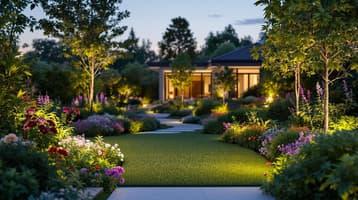
Ultimate Guide to Smart Garden Lighting Setup
Learn how to enhance your outdoor space with smart garden lighting through effective planning, installation, and automation techniques.

Digital vs Traditional Garden Design: Pros and Cons
Explore the advantages and challenges of digital and manual garden design methods to find the best approach for your project.
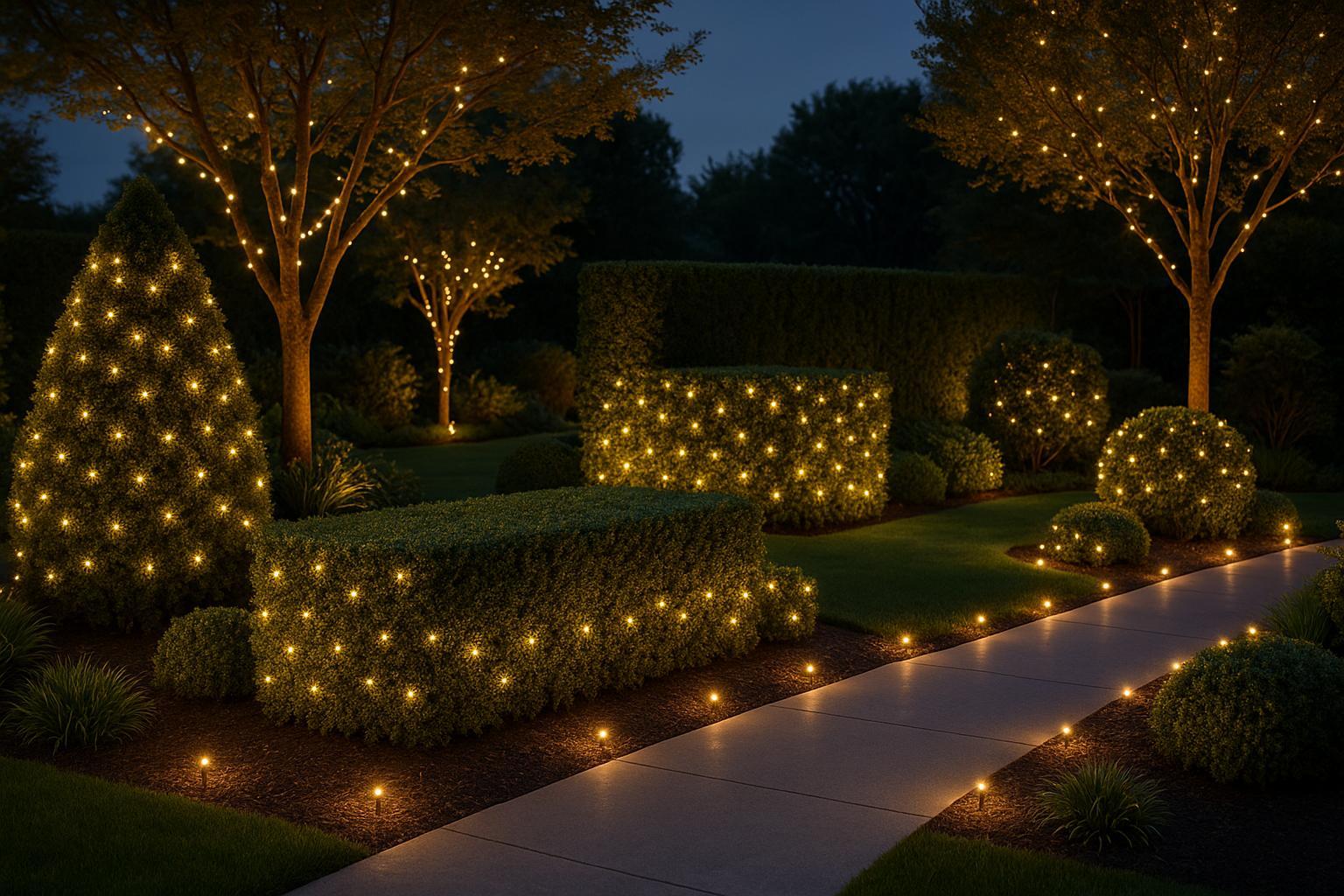
AI Holiday Lighting for Landscapers
Explore how AI is revolutionizing holiday lighting for landscapers, enhancing design efficiency, customization, and client satisfaction.

Using Charcoal Ash in the Garden: Benefits, Precautions, and Alternative Uses
Learn about the benefits and drawbacks of using charcoal ash in your garden, including how to use it safely and alternative uses for this soil amendment.

How AI Matches Colors and Textures in Gardens
Explore how AI simplifies garden design by matching colors and textures, creating personalized layouts for thriving outdoor spaces.
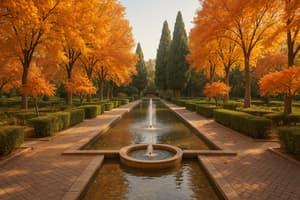
How Persian Gardens Adapt to Seasonal Changes
Explore how Persian gardens ingeniously adapt to seasonal changes through smart design, plant selection, and water features for year-round beauty.